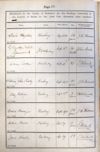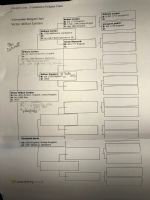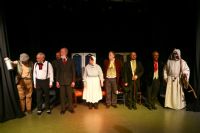WILIAM CORDEN
THE LATE MR. WILLIAM CORDEN
AN ARTIST'S RECOLLECTIONS OF THREE REIGNS
The death, on Friday last, of Mr. William Corden, removes from Newbury an interesting personality, interesting not only by reason of his advanced age, enabling him to remember much that is "history" to the younger generation, but also because of his connection as an artist with the court, and his reminiscences of many celebrated and exalted personages.
Born in Derby in 1819, Mr. Corden came to Windsor as a boy of ten years, whither his father, also an artist, removed to execute commissions for King George IV., (and afterwards for King William and Queen Victoria). The journey by coach from Derby to Windsor was one of Mr. Corden's vivid recollections - the furniture being carried all the way by barge, along the now almost forgotten system of canals, to the Thames.
After studying in London and working in the evenings at the Life-School in Clipstone-street (where Thackeray sends Clive Newcombe), which has years ago moved to rooms near the Langham Hotel, and now combines the Artists' Society with the Langham Sketching Club, Mr.Corden went to Germany in 1844 with his father, who was sent by Queen Victoria to paint for her in Coburg. On his return the Queen purchased nearly all the sketches he had made there, and from that time for nearly 40 years gave him constant commissions for portrait and other work, at Windsor, Buckingham Palace, Osborne, and Balmoral. During these years Mr. Corden painted nearly four hundred pictures for the Queen, besides exhibiting works at the Royal Academy for many consecutive seasons, the first being in 1846; in 1847 he exhibited "Early Grief," a child mourning over a dead dog, painted from a pet dog of the artist's which had been killed. "Indecisions," "The Windmill Seller," and "Queen Mab,' were among other exhibited works.
Although a portrait and figure painter, Mr.Corden did a great deal of landscape work also, and attributed much of his knowledge and love of landscape to the friendship of James Stark, the well known artist of the "Norwich School," who at one time was his neighbour in Windsor, and worked a great deal in Windsor. In 1848 he painted the portrait of the Duke of Brunswick, which hangs in the Waterloo Gallery at Windsor Castle, being assisted by the Prince Consort, himself a talented amateur, whose pencil sketches of details of uniform etc., were among the artist's prized possessions. Besides many pictures for the Queen Dowager, and others for the Duchess of Kent (the mother of Queen Victoria), he painted a portrait of Lord Bridport, which was engraved.
After this he was sent by Her Majesty to Lisbon, where he remained for four months, and executed life-size portraits of the King (a cousin of Albert), and the Queen of Portugal. These now hang in the galleries of Buckingham Palace.
Mr Corden had an amusing experience here. Thinking a violin would increase his baggage, he had purchased what was then a new invention, a concertina, and had learned a few airs from an instruction book. Hearing of this new instrument the King asked to see it, and then insisted on dragging Mr. Corden into a room full of people, to play it before the Queen. Unable to think of anything to play he began the first air which came into his head, and had got half way through, when he was horrified to remember its anti-monarchical and revolutionary character - it was the "Marseillaise." It was too late to stop, but he often said he wondered if they thought it was done intentionally. This, too, was the summer of 1850, with '48 of Paris fresh in all minds.
About this time, when painting at Buckingham Palace, he frequently saw the Duke of Wellington, then a very old man, who died in 1852 a year memorable in Windsor by reason of a severe flood, which stopped the traffic on the South-Western Railway.
Among other portraits for the Queen was one of Prince Arthur, now the Duke of Connaught, in his first uniform, that of a Woolwich cadet. The prince arrived in the room one day for a sitting with a little fair boy pick-a-back on his shoulders, whom he introduced as "my nephew." This was the present Emperor of Germany, who has now given up riding uncles.
Working so much at Windsor, Mr. Corden witnesses many historic scenes, from the visit of the King of the French (Louis Philippe), and that of the Emperor of Russia before the Crimean War, to the inspection of the troops after the Ashantee campaign, in which Sir Garnet Wolsey first loomed large in the public estimation.
The first visit of a Khedive of Egypt (then alluded to as the Viceroy) in 1869 was the occasion of a water-colour painting, now in the Queen's possession, of the Guards brigade crossing a pontoon bridge at Datchet, after the review in the Great Park. A replica of this is in the possession of the artist's son, Mr. Victor Corden.
Mr. Corden lived for a time in the village of Old Windsor, moving in 1853 to Datchet, where he married, and where he resided until in 1889, he came to Newbury to enjoy a well-earned rest.
It is not often, perhaps, that three generations, following the same profession, have done work for the same sovereign. Mr. William Corden, his father, and his son, Mr. Victor Corden, have all had the honour of the Queen's personal patronage.
His recollections and anecdotes of Windsor matters were numerous, and some of them may be interesting to Berkshire readers.
Windsor, in George the Fourth's time was very different in many ways from its present condition. Houses crowded up to the Castle walls in Thames-street and High-street, where the green banks now are and an inn stood among them near the foot of the "Hundred steps," which is worthy of notice because of one peculiarity. Half of it was in the parish of New Windsor, and half in the parish of St George's, Hanover-square, London (St. George's Chapel and some part of the Castle being in some wonderful way a part of the metropolitan St George's.) The dividing line between the two parishes was marked on the floor of the parlour, and here gentlemen in difficulties would sit and smile at the bailiff, who, though in the room, could not arrest them unless they crossed the magic line, which of course, they postponed until Sunday, when no debtor could be arrested, and when they could walk out and take the air.
At that time the last sedan chairs had not disappeared from the town, nor the last elderly to wear a "spencer," that tailless overcoat which became a fashion through a coat's tail being cut off for a wager.
It was a common sight then, when walking in Windsor Park, to see "the first gentleman in Europe" driving his mail phaeton, with a friend beside him, generally a certain nobleman who was not celebrated for his beauty.
A maiden from the west country came on a visit to her uncle who kept a lodge gate in the park; on the approach of the King's phaeton one day she, being very anxious to see King George, received permission to open the gate. On being asked afterwards what she thought of the King she replied (not dreaming that a King would drive himself) that "the King was the ugliest man she had ever set eyes on, but that he had a very handsome coachman!" Which remark we may be sure was not long in being conveyed to that "stout and elderly Adonis" as poor Leigh Hunt got two years in prison for describing him.
In those days and indeed as long as there was no railway to take people to a London Theatre, the leading actors and actresses often played on the boards of the Windsor Theatre. Among those of whom Mr. Corden often spoke of as having seen there were Charles Kean, Mrs. Nisbet, and the elder Farren, and in London Macready, Grisi, Mario; Taglioni and Phelps, Fechter, Charles Matthews and Madame Vestris; and when a boy he heard Paganini himself play at the Public Rooms in High-street, Windsor.
As a musical amateur Mr. Corden was a brilliant violinist, and played for many years in the Windsor Society under the baton of Sir George Elvey, where he frequently acted as leader of the orchestra. One of his earliest concert recollections was of playing in this orchestra before King William IV, and Queen Adelaide in what is now the Albert Memorial Chapel in 1837. The old King went fast asleep most of the time, but the Queen did her best to make amends by requesting one of the items to be repeated.
His remembrance of the procession in London at the Coronation of Queen Victoria was accentuated by the fact of having to walk about the streets all night, London being so crowded with visitors that it was impossible to get a bed.
Among the interesting objects which Mr. Corden leaves is a set of studies of some of the gems of the collection at Windsor, made during the intervals of work, by the verbal permission of the Queen, and various interesting portraits and autographs of different members of the Royal Family.
Living very quietly in Newbury Mr. Corden was known to comparatively few, but those who had the privilege of his acquaintance found in him an endless fund of interesting and humorous anecdote, and many, especially the little folks who were his neighbours, will miss a kindly and cheery friend.
Newbury Weekly News 13 September 1900
Mrs P p77 N Ch (A)4
Died 13 September 1900 age 78
Book 1899 page 018 no 7339



.jpg)
.jpg)


